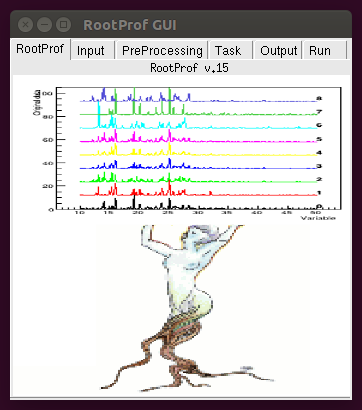RootProf

RootProf applies multivariate analysis to big data collected from in situ/operando multi-probe experiments. It is based on the data analysis framework ROOT, developed at the European Center for Nuclear Research (CERN). Data processing is mostly probe-independent, so it can handle data collected from single-crystal or powder X-ray diffraction experiments, as well as from scattering (SAXS) and spectroscopic experiments (XAS, FT-IR, Raman etc). Input profiles are pre-processed with methods that are specific of the measurement technique.
Various analyses can be performed:
-
qualitative analysis, aiming at extracting the trends in data and grouping the profiles according to their main features. It is based on principal component analysis (PCA);
-
quantitative analysis, aiming at assessing the weight fraction of pure-phase components in mixtures. It can be performed by two methods: (i) MultiFit, which is based on the whole pattern fitting of mixture profiles with those from pure phases; (ii) Unfolding, based on matrix computation, which is faster but less accurate. Both methods can be also applied for supervised quantitative analysis, where the known weight fraction from a subset of samples is actively used to improve estimates on the remaining samples. It is also possible to couple qualitative and quantitative procedures, combining the PCA with least squares to improve the estimates of the fractions by weight;
-
morphological analysis, aiming at assessing the average size of crystallites composing the powder samples (only possible in case of X-ray powder diffraction patterns). It is based on the analysis of the width of a specific peak;
-
crystallinity analysis, aiming at assessing the degree of crystallinity of a powder sample by whole-profile fitting methods;
-
covariance analysis, aiming at correlating features seen from different techniques in case of multi-probe experiments.
-
kinetic analysis, aiming at extracting the kinetic model that best describe your data, and to estimate kinetic parameters such as critical temperature, activation energy and order of transition.
RootProf implements a procedure devoted to data analysis according to the Modulated Enhanced Diffraction theory [Caliandro R. et al. Patterson selectivity by modulation-enhanced diffraction (2012) Jour. App. Cryst., 45, 458-470. doi:10.1107/S0021889812011569].
The program has a graphical user interface or can be guided by editing a command file in text format. The results consist of written text and graphics, the latter appearing in interactive windows. Data processing is fast, so it can also be used for on-site monitoring of the experiment.
RESEARCH AREA
KEYWORDS
Software Reference:
Caliandro R. and Belviso B.D.
RootProf: software for multivariate analysis of unidimensional profiles
J. Appl. Crystallog. (2014). 47, 1087-1096 doi:10.1107/S1600576714005895
RoofProf was applied and cited in:
Zappi A., Maini L., Galimberti G. et al. “Quantifying API polymorphs in formulations using X-ray powder diffraction and multivariate standard addition method combined with net analyte signal analysis” (2019) Eur. J. Pharm. Sci., 130, 36-43 doi:10.1016/j.ejps.2019.01.014
Guccione P., Palin L., Belviso B.D et al. “Principal component analysis for automatic extraction of solid-state kinetics from combined in situ experiments” (2018) Phys. Chem. Chem. Phys. (HOT Article), 20, 19560–19571. doi:10.1039/c8cp02481b
Guccione P., Palin L., Milanesio M. et al. “Improved multivariate analysis for fast and selective monitoring of structural dynamics by in situ X-ray powder diffraction” (2018) Phys. Chem. Chem. Phys., 20, 2175–2187. doi:10.1039/c7cp06326a
Caliandro R., Belviso B.D., Cuocci C. et al. “Dynamic characterization of structural changes in vapochromic compounds by pair distribution function” (2017) Powder Diffr. 32, S118–S122 doi:10.1017/s0885715617000094
Palin L., Caliandro R., Viterbo D., Milanesio M. “Chemical selectivity in structure determination by the time dependent analysis of in situ XRPD data: a clear view of Xe thermal behavior inside a MFI zeolite” (2015) Phys. Chem. Chem. Phys. 17, 17480–17493. doi:10.1039/c5cp02522b


